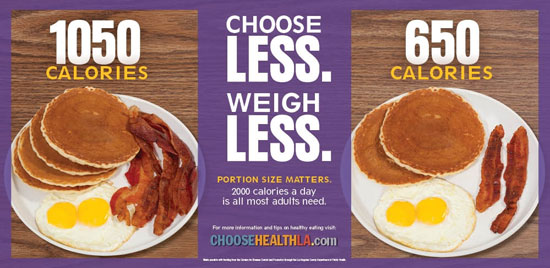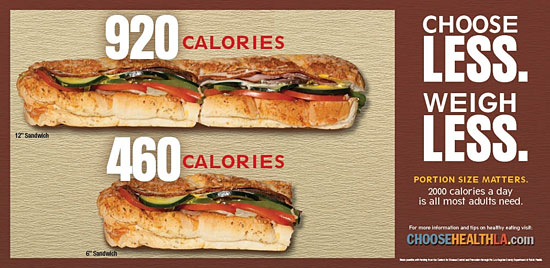And hold the extra calories
October 4, 2012
Quick: How many calories should an average adult consume daily? Should growing boys and girls eat more than their parents or less?
If you didn’t know that 2,000 calories a day is plenty for most adults and that most children need even fewer, keep your eyes out for Los Angeles County’s latest front in the surging obesity epidemic—a sweeping new public education campaign aimed at getting people to reduce their food portions.
The initiative was launched last week in Spanish and English on billboards, buses, web banners and other media. And it’s coming none too soon, according to a new report from the Los Angeles County Department of Public Health.
In a survey released this week, public health officials found that adult obesity rates here have risen by 74% since 1997, when the county first began tracking the problem. Obesity now afflicts nearly a quarter of Los Angeles County’s adults, with rates in some parts of the county exceeding 30%.
In South L.A., for example, about one adult in three is obese now. In East L.A., the rate is 30.1%. In the Antelope Valley, which has the county’s biggest weight problem, the rate has more than doubled to nearly 35%—roughly the same as Mississippi’s. (The Westside, by comparison, has an obesity rate of less than 10%.)
The local findings correlate with trends across the nation, where the overall obesity rate—the percentage of people with an overall body mass index of 30 or higher—has reached epic proportions. Obesity is approaching tobacco use as the leading preventable causes of death in the U.S., and its attendant medical costs are estimated at $147 billion to $210 billion a year.
A recent state-by-state projection by the Robert Wood Johnson Foundation found that if Americans continue on the current trajectory, obesity rates could top 44% within the next two decades in every state in the nation, including California, and more than half of the states could have obesity rates of more than 50%.
The situation, which is not only shortening lives but threatening efforts to contain healthcare costs, has prompted national, state and local intervention. New York, which has been in the movement’s forefront, recently became the first city in the nation to ban the sale of sugary drinks larger than 16 ounces and has launched a push to get rid of sugary and fatty food in hospitals.
In Los Angeles County, initiatives have ranged from ads depicting the amount of sugar in non-diet sodas to campaigns to improve nutrition in day care centers and pre-schools. The result, the public health department report notes, has been “a hint of a decline” in children’s obesity rates.
But Paul Simon, Director of the DPH Division of Chronic Disease and Injury Prevention, says that, even at its current plateau, childhood obesity here remains a profound problem and that’s “no evidence the obesity epidemic among adults in the county is stabilizing.”
“The rate of increase may be slowing,” he says, “but it’s still going up.”
Consequently, health officials are going back to basics in trying to educate the public on the kinds of habits that make people overweight. The current campaign, expected to cost slightly less than $1 million, is being funded by a grant from the Centers for Disease Control and Prevention and managed by the county’s Choose Health LA campaign.
“Obesity is a problem that starts early,” says Simon, “and one that continues to get worse with time. So we are doing many different things to address it. Portion control isn’t the only intervention, but it’s an important one.”
Portion sizes have ballooned over the last two decades. (For an eye-opening quiz, click here.) Study after study has shown that larger portion sizes make us eat or drink more. Even a feeling of fullness won’t stop us.
“We’re wired to eat what’s on our plate,” says Simon. And, he says, most of us don’t have a clue how many calories we’re consuming. To test market their campaign, DPH convened two local focus groups, in Spanish and English, and conducted an online survey with nearly 700 Los Angeles County respondents. One of the most startling discoveries was that most Angelenos don’t even know how much they can eat—or feed their children—without gaining weight. Some respondents thought 4,000 calories a day was the recommended allowance, others were sure it was more like 500.
In fact, the U.S. Department of Agriculture estimates that adult women only need 1,600 to 2,400 calories per day, and adult men only need 2,000 to 3,000. Young children need only 1,000 to 2,000. And unless you’re an athlete, you should be saying “when” at the lower end of those ranges. A grand-slam breakfast, a 12-inch sandwich, three slices of pizza, a bowl of spaghetti with two meatballs, a double-double with large fries—for most people, any one of these could, in a single sitting, dish up half of a full day’s calories.
But a second discovery, borne out in other studies, was that too harsh or challenging a message would simply cause some people to tune out. So the county campaign took the unconventional step of including ways to cut calories from the kinds of meals people were actually eating, as opposed to the healthier food they should eat.
The campaign’s images are not of broccoli and kale, but of smaller burgers and fewer slices of pizza, shown with their respective calorie counts next to the motto “Choose Less. Weigh Less.” Simon says the message is not necessarily to give up fast food and big restaurant portions, but to consider splitting an order, choosing a smaller plate or asking the server to put half in a to-go bag before bringing your food to the table.
The campaign is expected to get a boost from the federal health care reform law, which was upheld by the U.S Supreme Court this summer. Among the pending requirements of the Affordable Care Act is one that will require calorie counts to be posted in all chain restaurants with more than 20 outlets. (California has had a calorie-count law for nearly two years. But its implementation has been slowed because the new federal law has pre-empted it, as it has a county ordinance championed by Supervisor Zev Yaroslavsky.)
Though the fast food industry has, in general, resisted the posting of such information, a few chains, such as Panera Bread and McDonald’s, have voluntarily begun posting calorie counts on menus. This summer, McDonald’s experimented with a “Favorites Under 400” promotion of menu items with 400 calories or less.
Simon says that, down the road, the county might be able to build on that commercial involvement by encouraging restaurants to broaden their range of small-plates, offer half-orders or give patrons the option, before their food comes to the table, to save half of their entrée in a take-out box for later.
Yaroslavsky, a supporter of the county’s anti-obesity efforts, says the campaign “is one of many public health initiatives the County of Los Angeles is pursuing to help make our communities healthier.”
“Our aim is to give people access to healthy foods and beverages where they live, work and play.”
Posted 10/2/12















 405 bridge work causes a stink
405 bridge work causes a stink
